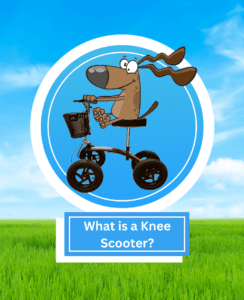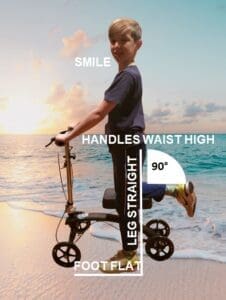
Knee scooters, also known as knee walkers, are mobility aids designed to help individuals with lower leg injuries or disabilities move around more easily. These devices have become increasingly popular in recent years, and for good reason. In this blog post, we’ll discuss the benefits of knee walkers, how they work, and what to consider when choosing one.
Introduction
A knee scooter is a mobility device that allows individuals with lower leg injuries or disabilities to move around while keeping their injured foot or leg elevated. They typically have four wheels, a padded platform for the knee to rest on (called the knee pad or seat pad), and handlebars for steering and braking. It comes in a variety of styles and sizes to accommodate individuals of different heights and weights. There are pediatric, adult, and big knee scooters.
A typical knee scooter is around 30 – 36 inches long by 16 – 20 inches wide when measured at the wheels. They weigh anywhere from 18 pounds to 30 pounds. Most are foldable and have adjustable handlebars and knee pads for a variety of rider heights. The typical knee walker can hold a maximum weight of 250 to 300 pounds with the big & tall versions capable of supporting a rider up to 400 pounds.
How do Knee Scooters Work?
Knee scooters are designed to be used with one leg, while the other leg remains elevated. The injured or disabled leg is rested on a padded platform, and the knee is bent at a 90-degree angle. The individual then steers the scooter using handlebars and moves forward by pushing off with their good leg. The four wheels on the scooter provide stability and allow for easy maneuverability.

Benefits of Using a Knee Scooter
1. Increased Mobility
Perhaps the most obvious benefit of using a knee scooter is the increased mobility it provides. For individuals with lower leg injuries or disabilities, getting around can be a challenge. Crutches can be tiring and uncomfortable to use, while wheelchairs can be bulky and difficult to maneuver. Knee walkers, on the other hand, are lightweight and easy to use, allowing individuals to move around more freely and comfortably. There are two models: standard and all-terrain. Standard models are mostly used indoors on hard surfaces such as hardwood floors, tile, or even carpet.
They can be used outdoors on very flat, smooth surfaces free of rocks, pebbles cracked sidewalks, or asphalt. All-terrain models can be ridden both indoors and outdoors since they have air-filled tires. The air-filled tires are typically 8-12 inches high by 2-2.25 inches wide thus giving them more versatility on many surfaces from indoor flooring to grass, dirt, sand, and light snow.
2. Improved Safety
Using a knee walker can also improve safety for individuals with lower leg injuries or disabilities. Crutches can be unstable and increase the risk of falling, while wheelchairs can be difficult to navigate on uneven terrain or in tight spaces. Knee scooters, however, are designed to provide stability and maneuverability, making them a safer option for many individuals.
3. Reduced Pain and Discomfort
Resting an injured or disabled leg on a padded platform can also help reduce pain and discomfort. With crutches, the weight of the body is often concentrated on the hands and underarms, which can cause pain and discomfort over time. Knee scooters distribute the weight of the body more evenly, reducing pressure on the hands and underarms and providing greater comfort.
4. Increased Independence
Finally, using a knee scooter can also increase independence for individuals with lower leg injuries or disabilities. With a knee walker, individuals can move around more easily without relying on others for assistance. This can be particularly beneficial for individuals who live alone or who have limited support from family or friends.
What to Consider When Choosing a Knee Scooter?
If you’re considering a knee scooter, there are a few factors to keep in mind when choosing one.
1. Weight Capacity
First and foremost, it’s important to choose a knee scooter that can support your weight. Most scooters have a weight capacity of around 300 pounds, but some models may have a higher or lower weight limit. Be sure to choose a knee walker that can safely support your weight.
Suggested read: Should You Rent or Buy a Knee Scooter?
2. Adjustability
Knee scooters come in a variety of sizes to accommodate individuals of different heights and weights. Look for a scooter that is adjustable to ensure a comfortable fit. Some scooters also have adjustable handlebars and padded platforms to further customize the fit.
3. Portability
If you plan to use your knee scooter outside of the home, it’s important to consider portability. Look for a knee walker that is lightweight and easy to fold or disassemble for transport. Some scooters also come with carrying bags for added convenience.
4. Wheel Size
Finally, consider the size of the wheels. Standard models typically have wheels of 7 to 8 inches while All-terrain models typically come with 12-inch wheels (rubber pneumatic tires like a bicycle).


